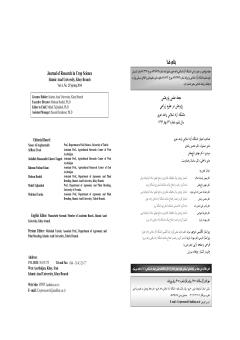تاثیر آللوپاتی چهار نوع علف هرز بر روند جوانه زنی و رشد گلرنگ تحت شرایط آزمایشگاهی و گلخانهای
محورهای موضوعی :
1 - Young Research Club, Islamic Azad University-Khoy Branch, Khoy, Iran
کلید واژه: آللوپاتی, علف های هرز, جوانه زنی و گلرنگ,
چکیده مقاله :
یکی از ابزارهای کاهش مصرف سموم علف کش، استفاده از خاصیت اللوپاتی موجود در برخی گونه های گیاهی می باشد. با توجه به فراوانی علف هرز ارزن وحشی، تاج خروس، پیچک صحرایی و سلمه تره در مزارع و اهمیت گلرنگ به عنوان یک گیاه روغنی مهم، این تحقیق به منظور ارزیابی اثرات آللوپاتی عصاره حاصل از اندام هایی هوایی و ریشه ای این علف های هرز بر جوانه زنی و رشد گلرنگ به صورت آزمایش فاکتوریل بر پایه طرح کاملا تصادفی در 3 تکرار در سال 1389 در آزمایشگاه و گلخانه دانشگاه آزاد اسلامی واحد خوی اجرا گردید. تیمارهای آزمایشی شامل محلول های بدون عصاره( شاهد)، 5/0، 1، 5/1 و 2 درصد عصاره اندام های هوایی و عصاره ریشه چهار نوع علف هرز ارزن وحشی، تاج خروس، پیچک صحرایی و سلمه تره بود. تجزیه واریانس نتایج حاصل از بررسی آزمایشگاهی نشان داد که اثر نوع علف هرز بر روی صفات طول ریشه چه و ساقه چهو درصد جوانه زنی معنی دار بود. به طوریکه بیشترین درصد جوانه زنی در حضور علف هرز پیچک صحرایی با میانگین 01/90 درصد و کمترین درصد جوانه زنی نیز در حضور علف هرز سلمه تره با میانگین 06/80 حاصل شد. همچنین اثر غلظت عصاره آبی علف های هرز بر تمامی صفات مورد بررسی به غیر از کلروفیل معنی دار گردید و بیشترین درصد جوانه زنی نیز در غلظت صفر درصد( شاهد) با میانگین 60/91 درصد مشاهده شد.تجزیه واریانس نتایج حاصل از بررسی صفات گلخانه ای نیز نشان داد که اثر نوع علف هرز در ارتباط با صفات تعداد غوزه و تعداد دانه در غوزه، وزن دانه در گیاه، بیوماس، شاخص برداشت و وزن خشک ریشه معنی دار بود. در این بین بیشترین وزن خشک گیاه و عملکرد دانه در بوته با میانگین 5/20 و 52/3 به ترتیب در حضور علف هرز پیچک صحرایی شد. همچنین اثر پودر گیاهی علف های هرز بر روی صفات تعداد غوزه و تعداد دانه در غوزه، وزن دانه در گیاه، بیوماس و وزن خشک ریشه در سطح احتمال یک درصد معنی دار بودند. و بیشترین بیوماس و عملکرد دانه به ترتیب با میانگین 84/18 و 12/3 در غلظت 6/0 درصد وزنی خاک گلدان حاصل شد.
Ahmadzadeh,A., I.Majidi, B.Alizadeh and A.H. Omidi.2010. Effect of grain yield, component yield and morphological characters of spring safflower by multi-variance statistical method. Agricalturan new science. Vol6,No18. 1-8
Bagheri,A., B.yazdisamadi, M.Taeb and M.Ahmadi. 2006. Evaluation of correlation and relationship of yield and other quantity and qualities characters of safflower, Agricultural Science and Method Journal of Iran. Vol 31. 295-306.
Bhowmilk, P. C., and j. D. Doll. 1983. Growth analysis of corn and soybean response to Biology and Technology 46(2).
Bogatek R, Gniazdowka A, Stepien J and Kupidlowska E, 2005. ConvulvulusarvensisL.bread wheat genotypes under greenhouse and field conditions. Pp.124-127.
Chaniago, I., and R. Jessop. 2006. Weed interference in soybean (Glycine max). The Australian Society of Agronomy. Proceedings of the Australian Agronomy Conference, 258-263.
El-Khatib AA, Hegazy AK and Gala HK, 2004. Does allelopathy have a role in the ecology of Chenopodiummurale? Ann Bot Fennici 41: 37-45. European Allelopathy Symposium. 11-14 September, Malmo, Sweden. Fescue, ConvulvulusarvensisL., reedroot pigweed, and cutleat evening primrose on wheat. flux densities. Journal of Chemical Ecology 9(8): 1263-1280.
El-Khawas, S. A., and M. M. Shehala. 2005. The allelopathic potentialities of Acacia nilotica and Eucalyptus prostrate on monocot (Zea mays L.) and dicot (Phaseolus vulgaris L.) plants. Biotechnology 4(1):23-34.
Hejazi,A.A. 2000. Allelopathy(auto poisoning and other poisoning). Tehran University publishes
Filizadeh, Y. 2001. Evaluation of quantitative and qualitative characteristics of safflower lines. M.Sc. Thesis in Agronomy, Faculty of Agriculture, TarbiatModarres University, Iran. [In Persian with English Abstract].
Hilda GG, Francisco ZG, Maiti RK, Sergio ML, Elia LDRD and Salomon ML, 2002. Effect of extract of ConvulvulusarvensisL. and Sorghum halepenseL. on cultivated plants. Crop. Res. 23(2): 382-388
Hosseinpour, T. and Ahmadvandi, A. R. 2002.Study on correlation between some agronomic traits and seed yield in safflower genotypes under rainfed conditions. Abstracts of the 7th. Iranian Congress of Crop Sciences. Seed and Plant Improvement Institute, Karaj, Iran. Page 378 .
Jackulski.,D. and F. R. Waller. 1993.Seeds as allelopathic agents. J. chem.. 9: 1107-1117.
Khalili Mahalleh,J., F.Jalili and N.Hosseini. 2014. Effect of four kind of allelopathic weed on the germination and growth of forage sorghum. Journal of research in crop science. Vol:5, No20. 107-122.
Lu, Z.K., and Y. Yanar. 2004. Allelopathic effects of plant extracs against seed germination of some weeds Asian J. Plant Sci. 3: 472-475.
Lydon,J.,J.R.Teasdale and P.K.Chen.1997; Allelopathic active of annual wormwood (Artemisia annua) and role of artemisinin.Weed Sci.45:807-811.
Maeroofi,N. 2015. Allelopathicaly effect of four weed extract and residence on germination and growth of Dracocephalummoldavica. M.sc thesis of seed technology. Islamic Azad University. Khoy branch. 144 pp.
Rezaei,F., M. yarnia and B. Mirshekari. 2008. Alelopathicaly effect of Amarantusretreflexus ,Chenepodium album and cynedondactylon on growth of rapeseed. Aricultural new science, vol4, No10. 41-55
RangaRao V., M. Ramachandram and V.Anmachalam. 2002. An analysis of association of yield and oil in safflower(Carthamustinctorius L.). Theor. ApplGenel. 50:185-191.
Samdani,Band M.A.Baghestani. 2005. Allelopathicaly effect of various Artemisia specieson germination and growth of seedling of Avenafatua. Research and bilding Journal, No68. 125-142.
Scigler, D. S. 1996.Chemistry and mechanisms of allelopathic.Agron. J. 88: 876-885.
Vasilakoglou, I., K. Dhima, and I. Eleftherohorinos. 2005. Allelopathic potential of bermudagrass and johnsongrass and their interfrence with cotton and corn. Agronomy. Journal. 97:303-313.
Yamamoto A, Turgeon J and Duich J M. 1997. Field emergence of solid matrix seed primed Turf grasses. Crop science; 37: 220 - 5.
Yang, C. M., C. N. Lee, and C. H. Chou. 2002. Effect of three allelopathicphenolics on chlorphyll accumulation of rice (Oryza sativa) seedling: I. Inhibition of supply orientation. Institute of Botany, Academic Sinica, Nankang, Taipei, Taiwan.


